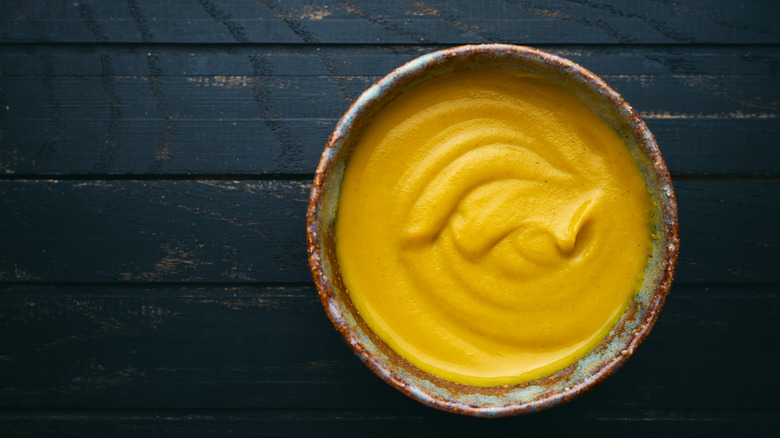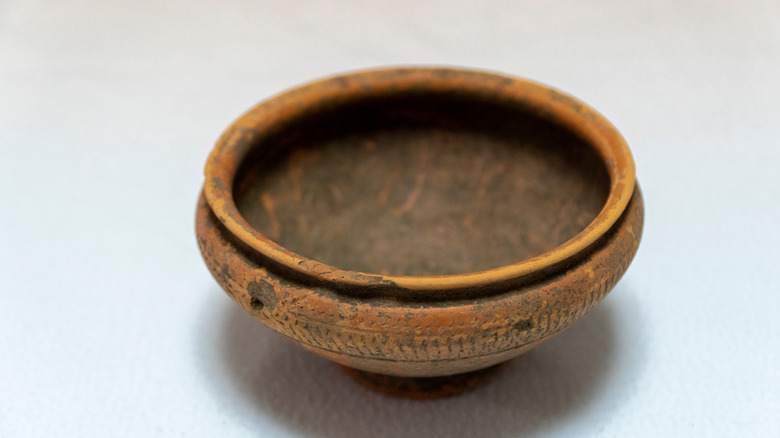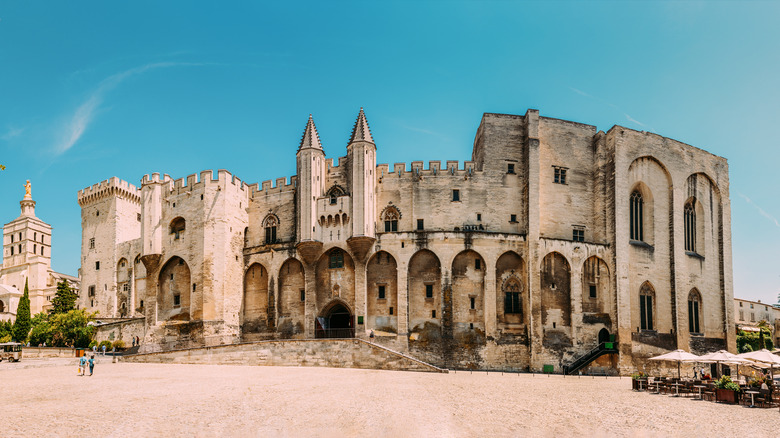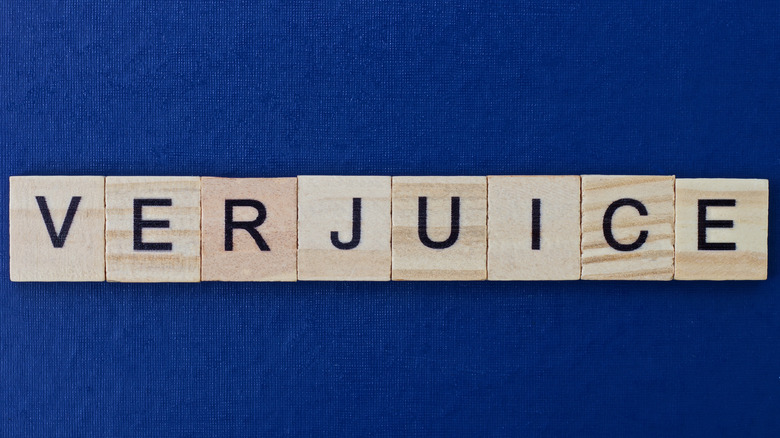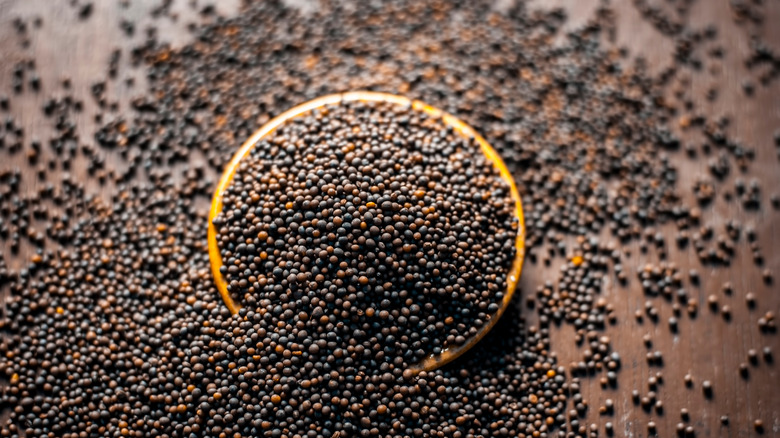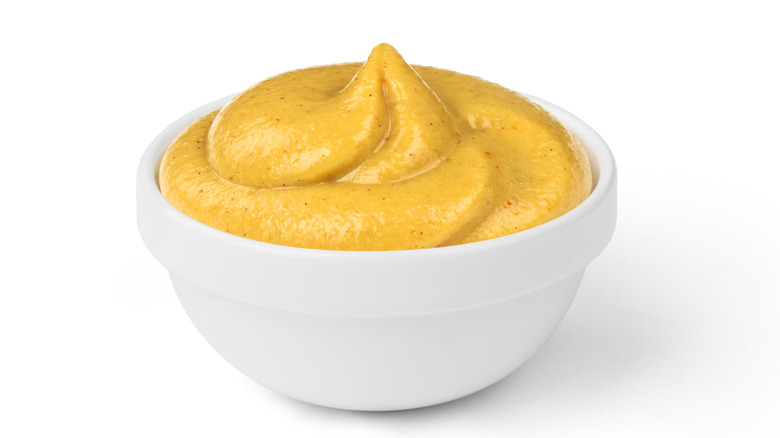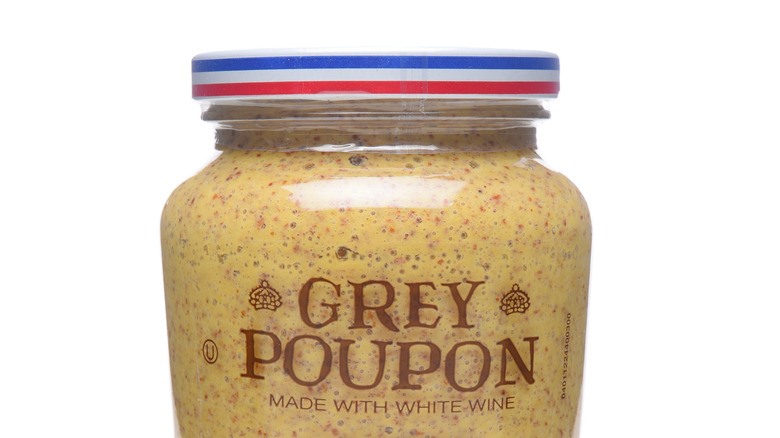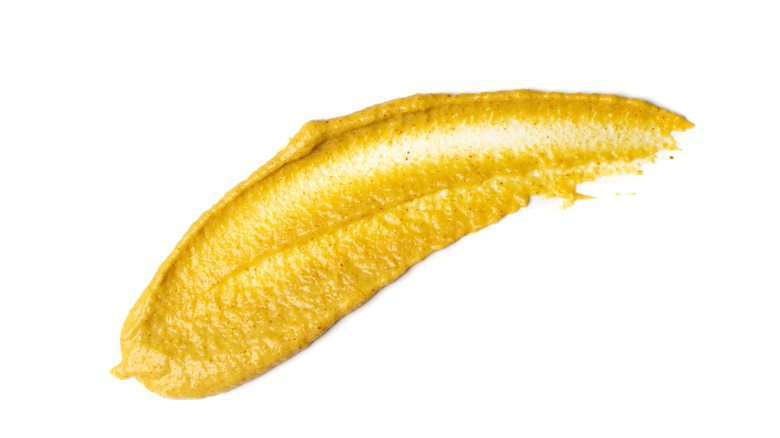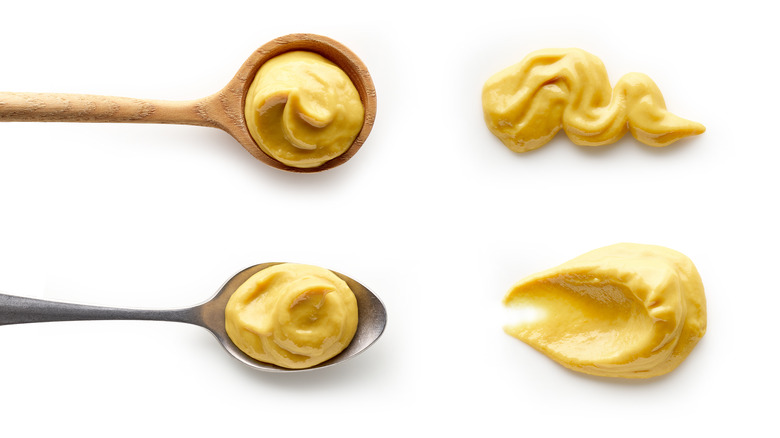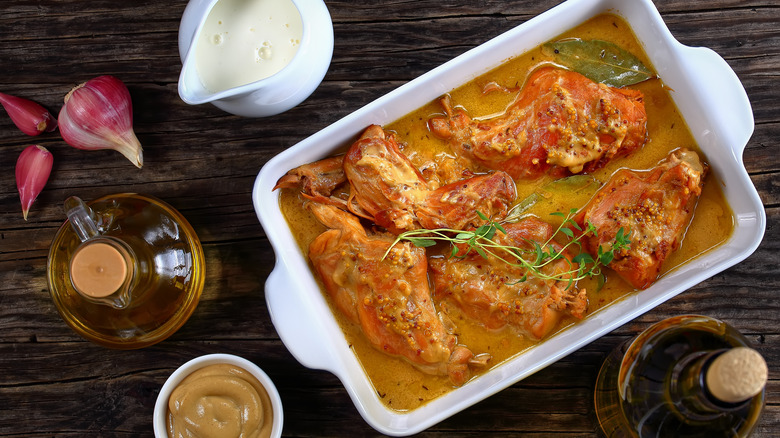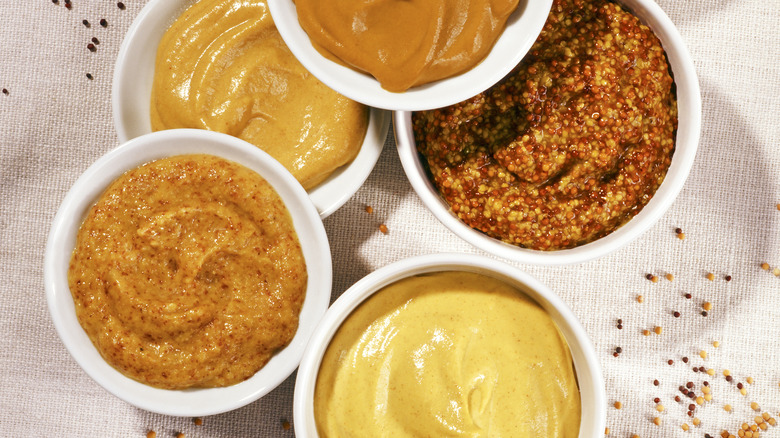The Untold Truth Of Dijon Mustard
An essential element of a French vinaigrette and perhaps the only condiment one can reasonably request at a stoplight, Dijon mustard is an all-time favorite for adding zip to sandwiches, salads, and more. But it's is far more than a fancy-looking spread with a fancy-sounding name. Rich with thousands of years of history beginning with the Ancient Roman occupation of what was then known as Gaul, and stretching to the modern era, Dijon mustard stands out from other members of the condiment aisle in more ways than one.
From its invention in France to its arrival elsewhere, from its key ingredients (and secret recipe!) to its purported health benefits, from its many flavors and iterations to its most common uses, from its richness in terroir to the odd naming protocols that once clued diners into where, exactly, the condiment was made, this is everything you need to know about Dijon mustard.
Dijon mustard has roots in ancient Rome
Despite its French-sounding name (we'll get to that in a second!) Dijon mustard's roots begin in Ancient Rome. According to Spiceography, the very existence of mustard in France is thanks to the settlement of the land known as Gaul by Ancient Romans, who didn't just plant the grapevines that would later become the source of the famed French wine, according to Bourgogne Wines, but, according to Spiceography, also co-planted mustard seeds in the vineyards. This practice, according to an article from the Sonoma County tourism board entitled "The Magic of Mustard in the Vineyards," provides essential nutrients and phosphorous to the vines.
While the Romans didn't stick around, their agricultural prowess had lasting effects on France. According to G.S. Dunn, the mustard plants continued to be cultivated by monks throughout France's northern winemaking regions, and by the 9th century, French monasteries were known for their mustard production.
Dijon mustard dates to 13th century Burgundy
While mustard seeds are cultivated and enjoyed the world over, from Indian curries to Chinese hot mustard, the prepared mustard spiked with a hit of zippy acidity that would inspire many forms of mustard we know and love in the West today started in the French winemaking region of Burgundy, in the 13th century, according to G.S. Dunn.
It was thanks to Pope John XXII of Avignon (at the time, there were two Popes – find out more from Avignon's Palais des Papes or Papal palace) who loved both his mustard and his idle nephew, that the mustard of Dijon gained particular acclaim. The outlet notes that the Pope created the position of "Grand Moutardier du Pape" or grand mustard-maker to the pope, in order to give his nephew something to do. According to The Good Life France, this gave rise to a popular French idiom: In French, "he thinks himself the head mustard-maker to the Pope" means that someone thinks too highly of themselves.
That said, according to The Spruce Eats, it would take hundreds of years for Dijon mustard to evolve from this first spread to the condiment we know and love today.
True Dijon mustard is made with verjuice
While, by the 18th century, Dijon had already long been known for mustard, according to L'Humanité, it wasn't until Dijon local Jean Naigeon created a special formula in 1752 that its recipe – and flavor – were fully established. According to The Good Life France, in his iteration of the spread, Naigeon used not the vinegar that the French government had decreed Dijon mustard should contain back in 1390, but rather verjuice.
According to Maggie Beer, verjuice literally means "green juice" – and it's an apt name for the substance. The juice of unripe grapes, verjuice is plentiful in wine country, lending a pleasantly sour flavor to recipes (much like lemons would, though the citrus is not endemic to Burgundy, despite arriving in the Mediterranean before grapes, by way of Greek traders, according to Behind the French Menu). As a seasoning for mustard, verjuice adds an unparalleled brightness and thus gives Dijon mustard its recognizable flavor profile.
Dijon mustard is made with brown mustard seeds
In addition to being made with verjuice, which, according to The Spruce Eats, hails from local white wine grapes and is therefore traditionally of the Chardonnay variety (the only white wine grape, aside from a bit of aligoté, that's allowed in Burgundy, according to VinePair), Dijon mustard must be made from brown mustard seeds.
Several different kinds of mustard exist around the world, ranging in color from white or yellow to black to brown. Yellow, according to Food Republic, are the mildest and the most common in the West, used in yellow American mustard. Brown and black are stronger in flavor and can be found in Indian curries, Chinese hot mustard, and, of course, Dijon mustard.
Brown mustard seeds, according to MySpicer.com, are spicier and more potent than yellow, giving Dijon mustard a far more intense flavor than many other mustards on the market. German mustards, as a point of comparison, often use a blend of both, according to The Spruce Eats, with a higher percentage of brown mustard seeds in scharf or sharp iterations of the popular spread.
It's different in both color and flavor from yellow mustard
Dijon mustard is quite distinct from what Brand Informers contends is America's favorite mustard: yellow mustard. While both spreads begin with mustard seeds ground into a paste, yellow mustard is made with white mustard seeds and gets its bright yellow color from turmeric, according to Food Republic. As a result, according to MySpicer.com, it has a far milder flavor than mustards made with brown mustard seeds, such as German mustard, English Colman's mustard (which, like German mustard, blends white and brown seeds), or Dijon mustard.
But the mustard seeds used in the two popular spreads aren't the only thing distinguishing them. Yellow mustard, reports MyRecipes, is made with a unique spice blend and uses vinegar for acidity, or even water. The resulting condiment boasts a milder flavor and less complexity than Dijon's verjuice-based recipe delivers, according to the outlet.
Grey Poupon was the first company to automate the process for making Dijon mustard
Grey Poupon's '90s ad campaign for Dijon mustard certainly made the brand famous stateside, but in reality, the company created far more than a quotable phrase.
In the middle of the 19th century, Maurice Grey was the inventor of the first steam-powered mustard seed mill, which would replace the hand-milling process that had been the standard until that point, according to Great British Chefs. According to the outlet, in 1860, after being awarded not just two medals but a Royal Appointment to improve the machine, he teamed up with Auguste Poupon – a Dijon-based mustard maker of renown – to form Grey Poupon in 1866.
But while Grey's machine was certainly a turning point for mustard, we can't discount the role of the commercials introducing a whole generation of Americans to the condiment, according to The Retro Network. The outlet notes that the commercials, which feature visibly wealthy passengers in Rolls-Royces, yachts, and more asking for Grey Poupon mustard in a way that connotes no small amount of extravagance, but also indicates that the average American can afford such luxuries as Dijon mustard. And it worked. According to The Retro Network, the commercial helped Grey Poupon increase its share of the mustard market from 2% in 1980 to 5% in 1984.
Today, Dijon mustard doesn't have to come from Dijon
French wine, cheese, and more are governed by a principle known as terroir, according to the podcast Navigating the French: the idea that the products made in a specific place are inextricable from the region they come from. Indeed, France even has a whole system of labeling legislation that imposes strict charters – including geographical limits – on things like Champagne, Brie cheese, and even Puy lentils. But Dijon mustard isn't lucky enough to benefit from a coveted AOP or AOC like these products – and as such, it can come from anywhere, not just from Dijon or even Burgundy.
According to Explore France, while at one point, Dijon-style mustard made outside of Dijon had to either be called "Dijon-style" or "dijon" with a lower-case d, today, the term is just a reference to the recipe, and one can make mustard dubbed Dijon anywhere from Dublin to Delaware. In 2008, Dijon's historic status as a mustard-making capital was reduced even further, as Amora Maille, one of the country's biggest mustard-producing companies, closed its historic Burgundian factory, first founded in 1900, Humanité reports.
Today, Edmond Fallot (founded in 1840) remains one of the only truly Dijonnais mustard makers, according to eDelices, boasting the only protected status for local mustard, created in 2011 thanks to efforts from the company. Mustards with the label IGP Moutarde de Bourgogne must use Burgundian white wine and mustard seeds (instead of the more common Canadian ones) in their formulas.
Dijon mustard is low in calories and fairly healthy
As compared to other common condiments like ketchup and mayonnaise, mustard is actually a fairly healthy choice. A tablespoon of sugar-laden ketchup contains 17 calories, according to Nutritionix; a tablespoon of mayonnaise, meanwhile, contains a whopping 94, the outlet contends, due to its richness in oil and eggs. But mustard contains just 9 calories per tablespoon, according to the outlet, and what's more, it also contains loads of good stuff.
A member of the brassica family, of which cabbage, broccoli, and kale are also members, according to Healthline, mustard boasts nutrients like calcium, potassium, zinc, and B vitamins, according to Nutrition Realm. That said, the outlet is also quick to note that given the small quantities usually consumed, it's tough to reap any measurable benefits from mustard.
According to VeryWell Fit, however, there are a few measurable health benefits of mustard, notably thanks to the presence of the antioxidants isothiocyanates and sinigrin. The former, which gives mustard its pungency, has been attributed with anti-cancer benefits; the latter is a precursor for isothiocyanates and boasts not just anti-cancer benefits but antimicrobial as well as anti-inflammatory characteristics.
Dijon mustard is a common ingredient in French cooking
In France, Dijon mustard is used as often as a condiment as it is as an ingredient. In French homes, you'll find it served alongside roast chicken or steak, and it is as common (and delicious!), according to The Spruce Eats, in vinaigrettes as in roasts like pork tenderloin or chicken slathered in the spread before taking a trip through the oven.
According to the outlet, the phrase "à la dijonnaise" is used to refer to any dish made with a Dijon mustard-based sauce. One of the most common such dishes is lapin à la moutarde, or rabbit with mustard, the recipe for which calls for a whole jar of mustard (never fear – thinned with cream and cooked in the oven, the pungency is diminished considerably).
French cooking aside, Dijon mustard is also a phenomenal accompaniment to corned beef sandwiches, hot dogs, or even grilled cheese.
Dijon mustard is available in several different grinds and loads of flavors
While the base recipe for Dijon mustard doesn't really change all that much, there are actually loads of different varieties of this classic French spread.
According to Kitchen Project, Dijon mustard is available in three different grinds: fine, country-style, and coarse. Fine is the smooth, spreadable variety you're probably most used to seeing, while coarse has lots of visible seeds in it. Country style is somewhere between the two.
And in addition to the different grinds, there are also multiple flavors of Dijon mustard. Paris' Maille mustard boutique, for example, sells flavors ranging from green pea and shallot to orange confit with ginger, reports The Good Life France; Edmond Fallot purports to combine flavors "like a great chef," with flavors of its IGP-protected Burgundian mustards that feature ingredients like French tarragon, Périgord walnuts, Dijon gingerbread, honey, balsamic vinegar, and more.
